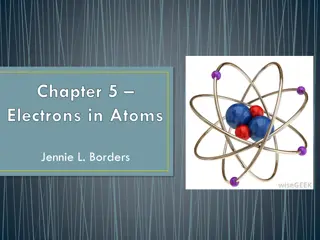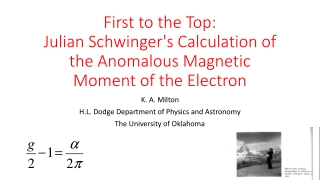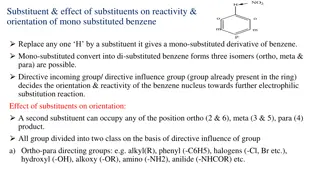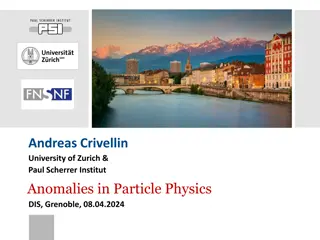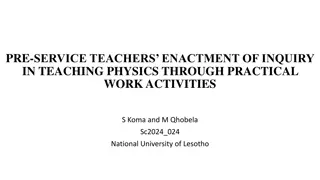Quantum Physics Research on Electron Wavefunctions and Double-Beta Decay
Researchers at the University of Tsukuba study electron wavefunctions using the Dirac equation and analyze double-beta decay in nuclei. The calculation of phase space factors, nuclear matrix elements, and bound and scattering states of electrons are explored to understand fundamental particles and their interactions.
Download Presentation
Please find below an Image/Link to download the presentation.
The content on the website is provided AS IS for your information and personal use only. It may not be sold, licensed, or shared on other websites without obtaining consent from the author. Download presentation by click this link. If you encounter any issues during the download, it is possible that the publisher has removed the file from their server.
Presentation Transcript
Bound and scattering states of the electron wavefunctions calculated with the Dirac equation for 0 Atsuya Kanai Collaborator, Nobuo Hinohara Nuclear theory group, Center for Computational Sciences, University of Tsukuba 1
Double-beta decay In some nuclei, two neutrons (or protons) simultaneously undergo beta decay 48Ca 76Ge 82Se etc Fermi particles that do not distinguish between particles and antiparticles Majorana particles Neutrinos may be Majorana particles Double beta decay without emitting neutrinos is allowed (Neutrino-less double-bata decay 0 ) 2
Phase space factor Nuclear matrix element For 0 we have following equation Phase space factor Half-life Effective neutrino mass Axial vector coupling constant Electron mass Effective neutrino mass can be determined by calculating nuclear matrix element and phase space factor Want to calculate phase space factor Requires wave functions of high-energy (fast) electrons emitted at 0 Need to solve Dirac equation! 3
Purpose of the study In preparation of phase space factor calculation Calculate the wavefunction of the electron in the bound states for the hydrogen atom, and compare the obtained energies and the wavefunction with the analytical solutions Calculate the wavefunction of the electron in the scattering states for the nucleus undergoing double-beta decay 4
Dirac equation in central field In central field, wavefunction can be product of radial and angular wavefunction ? = ? 1/2 The radial part satisfies the following simultaneous differential equations ??2 ? 1 ? ? = 4??0 is relativistic quantum number Solve this equation using the fourth-order Runge-Kutta method 5
Calculation of bound states To calculate the radial wavefunctions of bound electrons Solved from ? = ? up to ????= 10 (106 fm) Step size (10 fm) Initial conditions of the wavefunction were set as follows , , Constants required for calculation The energy is determined at G(r) becomes zero at ? = ???? The wavefunction was normalized under the following conditions 6
WavefunctionsS orbital 0.001 2S1/2 3S1/2 Wavefunctions of S orbital (? = 0) up to ? = 3 0 F(r) ( ) Dashed lines are analytical solutions 1S1/2 -0.004 0 10 r ( ) 1.2 1S1/2 G(r) ( ) 1S is almost identical to the analytical solution 0 3S1/2 As n increases, the wave function spreads farther 2S1/2 -0.8 10 0 r ( ) 7
Calculation resultsS orbital Comparison of binding energies [eV] of S orbitals up to n=3 analytical solutions Analytical solutions (relativistic, non-relativistic) 1S orbitals match in 7 digits of accuracy As n increases, accuracies of the energies got worse 8
Calculation of scattering state To calculate the radial wavefunctions of scattering electrons 48Ti, daughter nucleus of double-beta decay of 48Ca The energy of the electron is set to be ? = 2 MeV The coordinates of the nth point are set so that ??= 0.001(?0.00005? 1) Because we need the values of the wavefunction at the surface of the nucleus for the calculation of phase space factor and also need to fit analytical solutions to the calculated wavefunctions Potential was changed as follows (assuming charge distribution of nuclei as uniform sphere) 3 ?/?2 2? ?? ? ? ?? ? , ? < ? , ? = 1.2?1/3 fm ? ? = , ? ? 9
Wavefunctions near the origin 0.0008 F(r) ( ) Oscillate at a very short wavelength (about 600 fm) 0 As expected, the wavelength is calculated from the energy to be about 600 fm ? =2? ? ?2 ???2 ? -0.0008 =2? 0 0.02 , ? = ? = 4.36 fm ? r ( ) 0.001 As expected, roughly three periods of waves are showing G(r) ( ) Almost in the form of a plane wave, but F(r) behaves quadratically near the origin 0 -0.001 0 0.02 ? = 4.36 fm r ( ) 10
Wavefunctions around 5 0.0008 Asymptotic solutions are shown in green F(r) ( ) 0 ? + ???2 2? ? ???2 2? sin(?? ?? 2 ?ln 2kr + ??) ??(?,?) ??(?,?) = -0.0008 ? cos(?? ?? 4.98 5 2 ?ln 2kr + ??) ??= ?/2, ? = ??2/ ? r ( ) 0.001 Normalize the wavefunctions by fitting to asymptotic solutions G(r) ( ) 0 The wavefunctions were fitted and normalized! -0.001 4.98 5 r ( ) 11
Summary In preparation of phase space factor calculation, we calculated wavefunctions and energies of electrons in the bound state for the hydrogen atom For 1S orbital, wavefunctions and energy eigenvalue are well matched to exact solutions For S orbitals which n = 2, 3, the accuracy of calculations is not good Then the wavefunctions of electrons in the scattering states for 48Ti Calculated wavefunctions and asymptotic solutions are matched Future Issues Incorporate screening effect of surrounding electrons into the potential Incorporate (if possible) many-body effects due to surrounding electrons Calculate phase space factor 12










